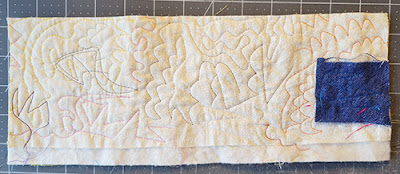What does a Tula Pink dinosaur (laying upon coordinating fabrics)....

...have to do with Manhattan?
(from my book, "Quilted New York")I found the pink dino, and its coordinates, irresistible at Manhattan's new and currently only quilt shop -- Keaton Quilts, high in a midtown office building, a shop that you have to know about in order to find.
You can't imagine how astonished I was to learn on Google that Manhattan was no longer a quilt shop desert. After nearly a half-year with no retail quilt store, quilt superstar Justin Stafford decided to do something about it. (See Justin's impressive bio at https://keatonquilts.com/pages/about-us). Justin opened the shop in May, and named it after his beloved dogs, who are named after actress Diane Keaton. It's on the 8th floor of a nondescript building at 150 W. 28th St., in Manhattan's flower district.
To reach it, you must thread your way through flower- and tree-cluttered sidewalks, go into an aging office building, (there's no sign), nod at the guy at the desk (who doesn't even look up), and take the elevator to the 8th floor. After a bit of wandering, I found a modest sign on a closed door, Suite 804. When I opened the door, like Manhattan's skyline, the scene was cluttered but glorious!

It's small -- you're looking at about a fourth of the store in this photo -- but the wares -- fabrics, notions, kits -- are neatly crammed and first rate. Hundreds of bolts of on-trend prints, luscious solids; several NYC themed fabrics; and most shelves were topped with flowing mountains and valleys of precut packs! There are also boundary-crossing kits (crochet, embroidery), and some kids' craft supplies. And lots of Berninas. There's a small class area, and the shop has a busy class and social sewing schedule. Learn more about all of these at https://keatonquilts.com.
Keaton is a worthy heir to a long lineage of fine Manhattan quilt shops. From 1997 through 2016, there was The City Quilter, which had a store front. I especially loved their witty NYC-themed novelty fabrics -- pigeons, taxi cabs, subway maps, etc. Although City's storefront is closed, they still sell their NYC fabrics online, at https://www.cityquilter.com/nyc-fabrics.html.
Then there was Gotham Quilts, with their own line of NYC-themed fabrics. But in the aftermath of Covid, Gotham too closed shop and now operates online, at https://gothamquilts.com/ Below, my 2018 photo the late, great, and relatively spacious Gotham.
Designer Victoria Findlay Wolfe had a micro shop in midtown; like Keaton, it was high in an office building, and you had to know about it to visit. It carried primarily her own products. That shop closed after Covid. (Her wares are online at https://vfwquilts.com/collections).
Why am I so emotional about having a quilt shop? Quilting and walking around Manhattan are two of my favorite things; here's the cover of my book about the connection, "Quilted New York; Celebrate the City with Fabric and Color." (Find paperback and digital versions in my shop, at https://cathypstudio.etsy.com.)

Also, for years now there's also been a shortage of quilt shops near my home in Pasadena, California. (Like Manhattan, we used to have loads of them, and now they are few and far between).
You may ask: What about all those other fabric shops in NYC's famed garment district, just north of the flower district? I've visited many over the years, from the tiny and ephemeral, to the eminent, multi-story Mood Fabrics, home base for Project Runway. But most wares in these shops are garment fabrics. Quilters' cottons are usually a token afterthought, if there at all.
Naturally, I recognized my moral obligation to support Justin's enterprise. And the prices are very reasonable. Along with several precut packs, one with the dinosaur, and loads of solids...

...I also bought a little set of colored pencils, geared to children, but I think it's great for me to use when designing on the road.
Couldn't beat the price! ($1.99!)
It even has a sharpener in the lid!
And almost as inexpensive, (I think it was $7.99) was a wooden seam roller, which I'd always wanted! I'd hate to lose this precious resource in Manhattan, so I hope you too, will visit Keaton Quilts when you are in New York. Now lest you accuse me of being a Manhattan chauvinist (guilty!), here are a couple more quilt shops in and near New York City (but not in Manhattan). I have heard good things about (but never visited)
-- Sewright Sewing Machines, in Bayside, Queens. https://www.sewright.com/shop/Fabric.htm
-- Brooklyn General Store, https://brooklyngeneral.com
-- On Long Island, I have visited Oh Sew Sally, in Rocky Point (by appointment only). Their website is https://www.ohsewsally.com/. It's run by my friend Roberta Leonard, and she has an excellent collection of fabrics, patterns and notions.
Got more? Let me know in the comments below. I'd love to add to my list of New York City-area quilt shops!










































































